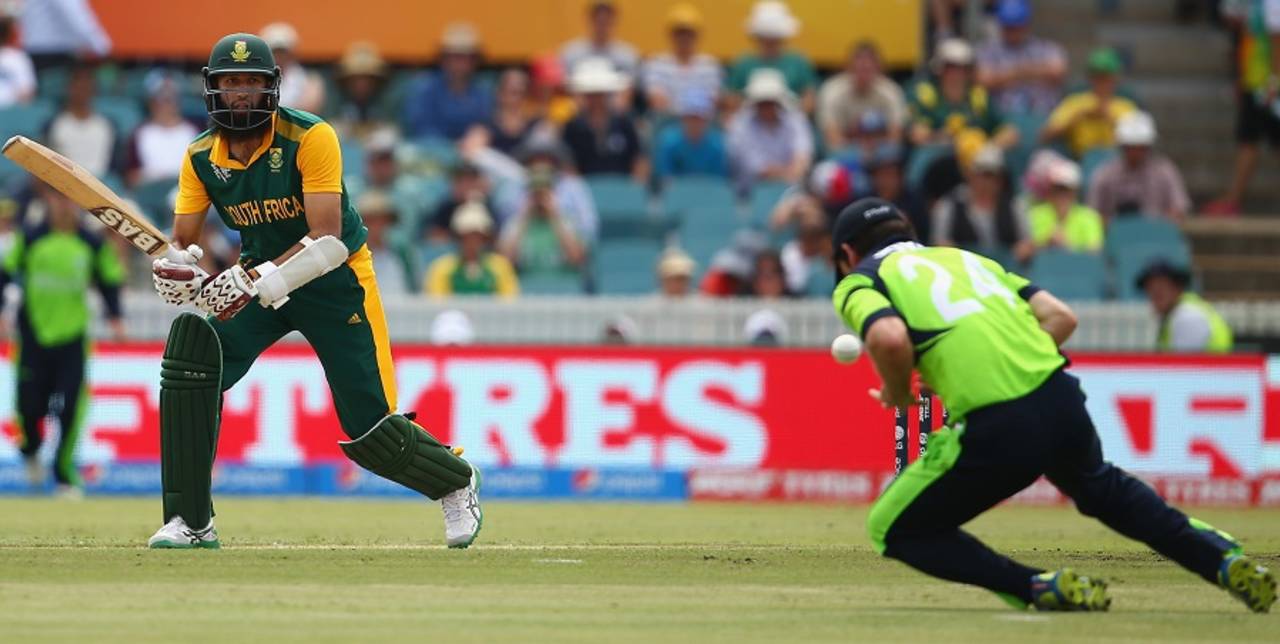"I suppose he'll make a hundred now."
These words, immortally uttered by Durham's wicketkeeper Chris Scott after turfing Brian Lara early in an innings that would balloon into 501 not out, could just as easily have escaped the lips of Ireland's Ed Joyce when he put down Hashim Amla at Manuka Oval. Certainly they must have run through Joyce's mind, for he has seen enough of Amla's skill to understand what was likely to follow.
South Africa's subsequent destruction of Ireland provided a reminder of how adept they have always been at disposing of lower-ranked opposition in World Cup fixtures that do not possess quite the same level of intensity or pressure witnessed during marquee group matches or the knockout rounds. But it also showed that for Ireland's bowlers, every possible advantage must be stolen by their fielders in order to avoid a lopsided scoreboard. It was a familiar tale for an Associate nation against more favoured opposition - the early optimism, the error, the deluge.
On a pitch ideal for batting but likely to slow up later in the evening, the early overs offered a slim window for Ireland to take enough wickets to limit South African ambition. John Mooney started with impressive parsimony, and sufficient nip off the seam to beat the bat. In the case of Quinton de Kock it was just enough to kiss the outside edge, though a referral and overturned decision by the third umpire Ian Gould was required to send the 'keeper on his way.
Mooney had been let down to some degree by the looser offerings of Max Sorensen, who bled runs even as his fellow new-ball seamer delivered maidens. It was to be the beginning of a damaging theme that ran through the innings - not enough partnerships were formed between bowlers and fielders as Amla and Faf du Plessis formed a union that would be defining.
But there had been hope of a manageable chase up to the moment that Kevin O'Brien replaced Sorensen. The first ball of a spell can occasionally bring a chance or at least an instance of re-adjustment for the batsman. William Porterfield posted a short midwicket for O'Brien, and a ball on the stumps was met with Amla's trigger movement across and an obliging flick to Joyce, right there.
But just as Amla did not seem fully conscious of the man in his vicinity, Joyce was not fully alert to the ball hurtling towards him, and his hands failed to close around it in time. Around Manuka, a largely Irish inclined crowd groaned, while Joyce looked ruefully towards the ground. Amla would, indeed, make a hundred now, to become by a distance the fastest man to 20 ODI centuries.
Ireland did get one more chance to split Amal and du Plessis, albeit a far harder one. Paul Stirling's unpretentious offspin has a knack for finding outside edges, and did so again when du Plessis leaned back to cut. O'Brien, having come up in expectation of the sorts of chances usually offered by the stroke, was unable to readjust when the edge flew lower between him and Gary Wilson. Whatever the subtlety, two opportunities missed left the Irish feeling they had missed the boat.
This became evident in a bowling display that lacked the cohesive adherence to plans Porterfield had so hoped for on match eve. His words about the need to bowl consistently to fields and steadfastly to plans, even when AB de Villiers is at his most destructive, were sound but went largely unheeded as Amla and du Plessis were able to manoeuvre the ball all too easily, helped by deliveries that veered too often into their hitting zones on either side of the wicket. The batsmen made this more damaging through their contrasts, Amla favouring the off side and du Plessis the leg.
In the end, de Villiers' threatened assault barely eventuated, though a tally of 24 from nine balls would be startling enough coming from any other batsman. Instead, it was Amla who made the bowlers look foolish, contributing to some truly ugly analyses for the bowlers. After Mooney's first five overs went for nine, his last two cost 43. Sorensen gave up 76 runs from six, and the cost of Joyce's drop to O'Brien was an unsightly leak of 95 runs in seven.
Ireland's pursuit was thus made in an atmosphere of idle curiosity rather than any genuine ambition of passing a distant 411. Dale Steyn and Kyle Abbott ensured that another sensation began to emerge fairly rapidly in the early evening - that of futility. The rearguard put on by George Dockrell and Sorensen provided South Africa with their only frustration and offered something for Irish spectators to cheer, but it was relevant only to the margin, not the outcome.
The gulf between the sides was such that by the close of the night it was possible to imagine that Joyce would not have been the only Irishman empathising with Scott after he dropped Lara that early June day in 1994. They had been well beaten, but what will grate is that they did not take every chance to avoid it being so.
Daniel Brettig is an assistant editor at ESPNcricinfo. @danbrettig
